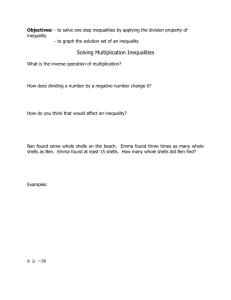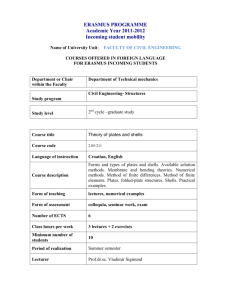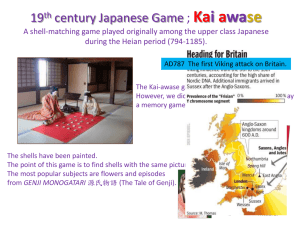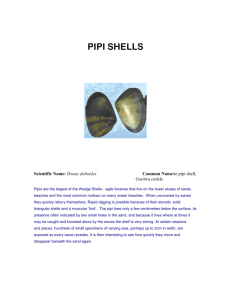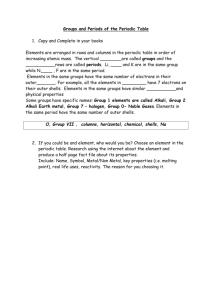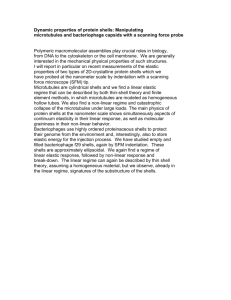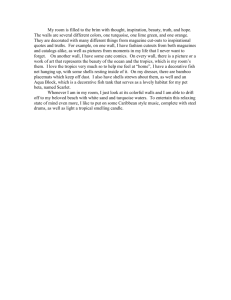Shell classification Homework Sheet
advertisement
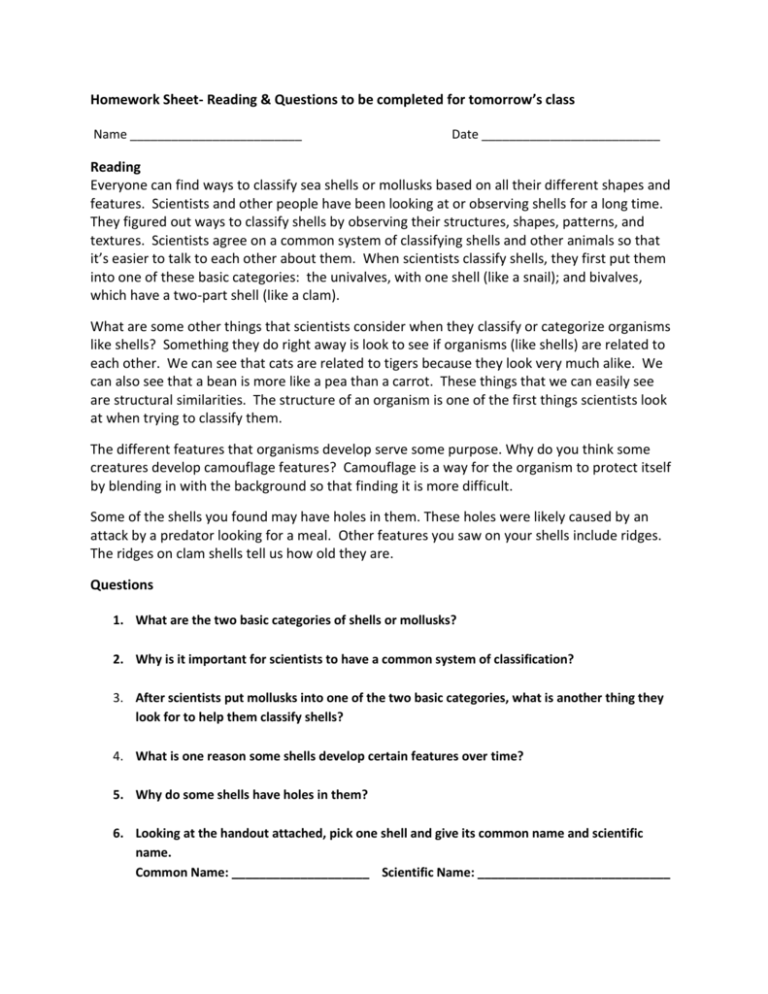
Homework Sheet- Reading & Questions to be completed for tomorrow’s class Name _________________________ Date __________________________ Reading Everyone can find ways to classify sea shells or mollusks based on all their different shapes and features. Scientists and other people have been looking at or observing shells for a long time. They figured out ways to classify shells by observing their structures, shapes, patterns, and textures. Scientists agree on a common system of classifying shells and other animals so that it’s easier to talk to each other about them. When scientists classify shells, they first put them into one of these basic categories: the univalves, with one shell (like a snail); and bivalves, which have a two-part shell (like a clam). What are some other things that scientists consider when they classify or categorize organisms like shells? Something they do right away is look to see if organisms (like shells) are related to each other. We can see that cats are related to tigers because they look very much alike. We can also see that a bean is more like a pea than a carrot. These things that we can easily see are structural similarities. The structure of an organism is one of the first things scientists look at when trying to classify them. The different features that organisms develop serve some purpose. Why do you think some creatures develop camouflage features? Camouflage is a way for the organism to protect itself by blending in with the background so that finding it is more difficult. Some of the shells you found may have holes in them. These holes were likely caused by an attack by a predator looking for a meal. Other features you saw on your shells include ridges. The ridges on clam shells tell us how old they are. Questions 1. What are the two basic categories of shells or mollusks? 2. Why is it important for scientists to have a common system of classification? 3. After scientists put mollusks into one of the two basic categories, what is another thing they look for to help them classify shells? 4. What is one reason some shells develop certain features over time? 5. Why do some shells have holes in them? 6. Looking at the handout attached, pick one shell and give its common name and scientific name. Common Name: ____________________ Scientific Name: ____________________________ Questions/Answer Sheet 1. What are the two basic categories of shells or mollusks? Univalve and Bivalve 2. Why is it important for scientists to have a common system of classification? Answer from class discussion: OR directly from the reading: Scientists agree on a common system of classifying shells and other animals so that it’s easier to talk to each other about them. 3. After scientists put mollusks into one of the two basic categories, what is another thing they look for to help them classify shells? Answer from class discussion: Scientists examine texture, shape, pattern and structure to help categorize one group of shells from another. OR directly from the reading: Something they do right away is look to see if organisms (like shells) are related to each other. 4. What is one reason shells develop certain features over time? One reason shells develop certain features over time is for camouflage, in order to hide from predators or enemies. 5. Why do some shells have holes in them? Some shells have holes in them because they were attacked by predators. 6. Looking at the handout attached, pick one shell and give its common name and scientific name. Common Name: Queen Conch Scientific Name: Strombus gigas (Various answers for question 6. Look through handout attached to confirm correct answers). Observations and Classification Table Name: _________________ Group Names: Texture Shape Pattern Structure __________ Date: _______________ __________ __________ _________ __________ Science Grade Six Lesson: Shell Classification Differentiation Activities 1. Use encyclopaedia or website www.conchology.com to look up a shell of your choice. Find out about the organs of the organism. List and make a diagram of the internal organs. 2. Find your favourite shell in the encyclopaedia or on the website www.conchology.com . List it’s common name and scientific name. Find interesting facts about it and list them. 3. Pick your favourite shell. Draw it and use adjectives to describe it. 4. Work with a partner and find the three classifications of shells. Name one shell from each group, giving its common name, scientific name, and where it is found. 5. Research the uses of shells over the years and in different cultures. 6. Endangered species of mollusks: Research shells (mollusks) that are common to our own beaches and find out if there are any that are endangered. Discuss in a group: Many people around the world love to collect shells as a hobby. Research how this may be affecting the environment or the shells/mollusks themselves.

